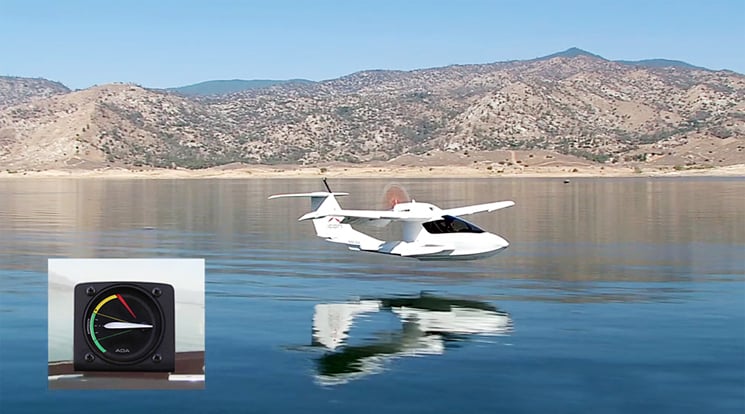
ICON Aircraft released details this week about its Angle of Attack (AoA) system, a safety feature that will be standard on the company’s A5 Light Sport Aircraft. ICON has completed the design, development, and testing of its AoA system, a feature rarely seen in General Aviation aircraft. ICON has also released a new video demonstrating the safety benefits and real-world implications of flying with AoA.
The A5’s AoA gauge delivers an intuitive graphical indication of the plane’s stall margin based on wing performance. Traditionally, pilots must evaluate an airplane’s proximity to stalling by observing the airspeed indicator; however, stall speed varies in relation to wing loading, something that an airspeed indicator does not account for. Pilots flying by airspeed are therefore forced to compensate for factors such as weight, g-load, aircraft center of gravity, and wind gusts. On the other hand, AoA is a single, easily understood metric that provides the pilot instantaneous information about how much lift the wing can deliver before it stalls. AoA gauges are common in military fighter aircraft, though cost and complexity have historically prevented their widespread use in General Aviation airplanes.
“Angle of Attack is likely the single most important parameter that helps a pilot fly safely at all times, and yet this information has not been made readily available in small planes,”
said ICON Aircraft Founder and CEO Kirk Hawkins.
“Angle of Attack is likely the single most important parameter that helps a pilot fly safely at all times, and yet this information has not been made readily available in small planes,” said ICON Aircraft Founder and CEO Kirk Hawkins. “Part of ICON’s mission is to produce one of the safest light aircraft ever created; incorporating an intuitive AoA system in the A5 is just another example of that commitment. Every fighter pilot in the world relies on AoA to help them land, keep them safe from unintended stalls, and max perform their aircraft. This safety technology should be available to more pilots especially new pilots and those flying small aircraft. ICON’s AoA gauge removes the ambiguity associated with using airspeed and gives our pilots a direct indication of how their wing is performing at any given time.”
The A5’s AoA readings incorporate a unique ICON design that intuitively conveys how the wing is flying. The gauge is positioned at the top of the instrument cluster, keeping it as close to the pilot’s line of sight as possible, and incorporates green, yellow, and red sectors to quickly convey how the wing is performing in real time.
The FAA has acknowledged the importance of Angle of Attack to small aircraft safety. An FAA Advisory Circular published in August 2012 suggests that a reduction in AoA is the single most important response in the event of a stall. The report emphasizes that AoA gauges allow the pilot to quickly assess the stall margin, which is useful in a wide range of scenarios–from preemptively responding to an impending stall to safely max performing the airplane while maintaining complete awareness of the available safety margin.
“The AoA gauge is an important reflection of how we think about flying and safety at ICON,” added Hawkins. “By once again synthesizing great design and engineering with outstanding user interface, ICON’s AoA gauge will make flying safer, more intuitive, and a lot more fun.”